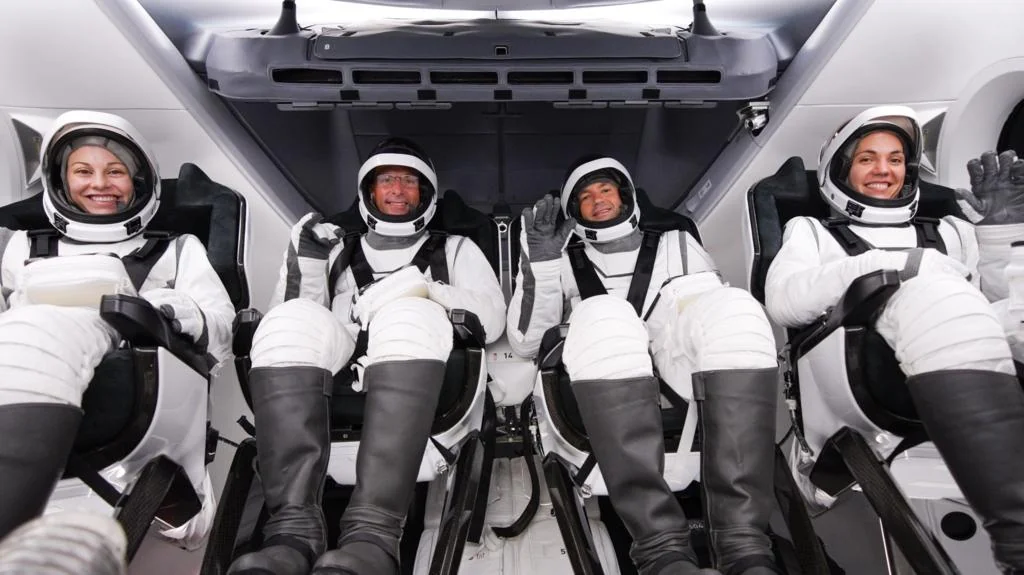
Billionaire Jared Isaacman, SpaceX Engineers Anna Menon and Sarah Gillis, and Pilot Scott ‘Kidd’ Poteet Set to Attempt First Privately Funded Spacewalk on Polaris Dawn Mission
Fiona Nanna, ForeMedia News
6 minutes read. Updated 5:13PM GMT Tues, 10 September, 2024
Billionaire entrepreneur Jared Isaacman has launched into space aboard a SpaceX Falcon 9 rocket, marking the beginning of the first privately funded spacewalk mission, known as Polaris Dawn. The mission is the first of three funded by Isaacman, the founder of Shift4 Payments, and aims to push the boundaries of private space exploration. Isaacman, serving as commander, is joined by retired Air Force pilot Scott ‘Kidd’ Poteet and SpaceX engineers Anna Menon and Sarah Gillis.
Their spacecraft, named Resilience, is set to achieve an orbit reaching up to 870 miles (1,400 km) above Earth—higher than any human has traveled since NASA’s Apollo program concluded in the 1970s. As the crew journeys through the Van Allen radiation belts, they will encounter radiation levels equivalent to three months of exposure on the International Space Station. The mission’s objectives include studying the effects of this brief but significant exposure on human physiology.
On the second day of their journey, the crew will reach their maximum altitude and conduct up to 40 experiments, including intersatellite laser communication between their Dragon spacecraft and SpaceX’s Starlink satellite network. If successful, the highlight of the mission will occur on the third day when Isaacman and Gillis attempt the first privately funded spacewalk, planned to last around two hours. This pioneering walk will test SpaceX’s new extravehicular activity (EVA) suits, which have been upgraded from intravehicular activity (IVA) suits to support work outside spacecraft.
The EVA suits are designed with flexibility and comfort in mind, featuring a heads-up display in the helmet that provides real-time suit information. Unlike traditional spacesuits, these new suits are intended to accommodate a broader range of astronaut body types, reducing the costs associated with custom-made garments. However, one of the mission’s unique challenges is that Resilience lacks an airlock; thus, the entire spacecraft will need to be depressurized for the spacewalk, with all crew members in EVA suits—even those staying inside.
In an interview during her training, Sarah Gillis emphasized the importance of this mission to SpaceX’s long-term ambitions: “SpaceX has huge ambitions to get to Mars and make life multiplanetary. Testing the EVA spacesuit is the first step towards making spacewalks and future suit designs even better.” Isaacman echoed this sentiment, noting the necessity of EVA capability for SpaceX’s goal of making life multiplanetary.
The mission also includes testing for conditions such as decompression sickness (the “bends”) and spaceflight-associated neuro-ocular syndrome, which can blur astronauts’ vision. These tests, along with those examining radiation exposure, are intended to lay the groundwork for future high-altitude missions, potentially to the Moon or Mars. However, the mission is not without risks. Dr. Adam Baker, a rocket propulsion expert from Cranfield University, pointed out, “They have set themselves a lot of ambitious objectives with relatively limited spaceflight experience, but they are mitigating risks with extensive simulation training.”
Should the mission succeed, it could signal a new era of private sector involvement in space exploration, expanding opportunities beyond government-funded missions. Yet, Dr. Baker remains cautious, noting, “Spaceflight is difficult, expensive, and dangerous, and expecting large numbers of non-ultra-wealthy individuals in space soon remains unlikely.”
Despite some criticism of billionaires funding their own spaceflights, space scientist Dr. Simeon Barber from the Open University argues that such private investments generate economic benefits on Earth, including job creation and scientific advancements. “The involvement of wealthy individuals in space exploration could create more diverse and resilient exploration programs,” Barber stated.
The mission’s outcome could set the stage for future private endeavors, opening doors for broader participation in space exploration and bringing humanity closer to the dream of reaching other worlds.
Backlinks:
- SpaceX’s Polaris Dawn Mission
- Jared Isaacman’s Shift4 Payments
- NASA Apollo Program
- Van Allen Radiation Belts

